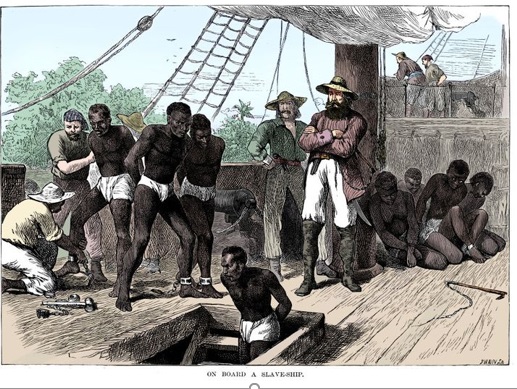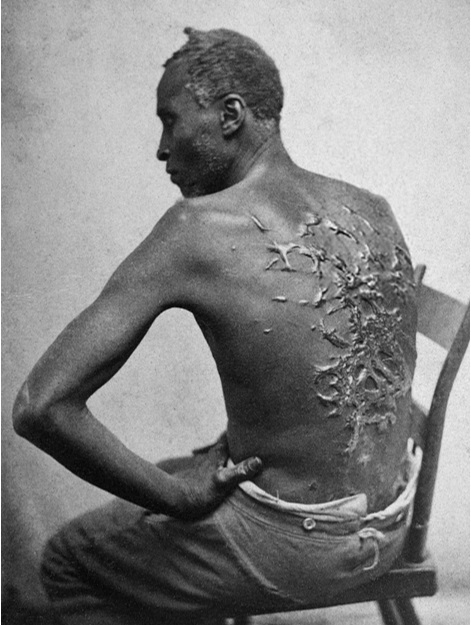 There are many books about the experiences of the enslaved however, there has not been an in-depth analysis of the psyches of the brutal white men and women who, for centuries, operated a system of brutality while they took away the voices of their captives. They enforced silence on the outside while the enslaved screamed on the inside. Much of this white planter class, and those who supported them, identified as godly Christians and yet, operated with no effect because they traded black bodies as property as they dehumanized them. It is time we reverse this kind of racial bias and break the intellectual and the psychoanalytic silence this era in our history helped to create. It is time we have a meaningful conversation about the unconscious, multi-generational, cumulative trauma caused by this history.
There are many books about the experiences of the enslaved however, there has not been an in-depth analysis of the psyches of the brutal white men and women who, for centuries, operated a system of brutality while they took away the voices of their captives. They enforced silence on the outside while the enslaved screamed on the inside. Much of this white planter class, and those who supported them, identified as godly Christians and yet, operated with no effect because they traded black bodies as property as they dehumanized them. It is time we reverse this kind of racial bias and break the intellectual and the psychoanalytic silence this era in our history helped to create. It is time we have a meaningful conversation about the unconscious, multi-generational, cumulative trauma caused by this history.
They would change our names to their own because we were just property. The enslaved would always be asked, “whose nigger are you?”
The enslaved had to be silent on the outside while screaming on the inside.
Religion played a major role in silencing the enslaved
While their captured cargo lingered in silence a new story was being placed over their own stories, laced with pain. Dudum Siquidem was issued in 1493 by the Catholic Church and gave Spain the right to capture, kill or convert non-believers in the newfound lands in the Americas and to take possession of the land and any valuables. These cruel Europeans not only trafficked millions of humans to distant lands, but they also captured land, resources and forced the Catholic religion on their victims — beating them into silence and killing others. The enslaved had to be silent on the outside while they screamed on the inside as their captors did as they pleased.
Catholicism played an important role at the beginning of the African slave trade it’s continuity. Three orders from the pope, called papal bulls, set into in motion the concept of “The New World.” Dum Diversas is a papal bull issued on 18 June 1452 by Pope Nicholas V. It authorized Afonso V of Portugal to conquer Saracens and pagans and consign them to “perpetual servitude claim all their possessions “.This order was extended to the Americas in 1493. Inter caetera was a papal bull issued by Pope Alexander VI on the fourth of May 1493, which granted to the Catholic Majesties of Ferdinand and Isabella (as sovereigns of Castile) all lands to the “west and south”.
 Romanus Pontifex, Latin for “The Roman Pontiff” is a Papal bull written in 1454 by Pope Nicholas V to King Afonso V of Portugal. As a follow-up to the Dum Diversas, in 1452, it confirmed to the Crown of Portugal dominion over all lands south of Cape Bojador in Africa. Along with encouraging the seizure of the lands of Saracen Turks and non-Christians, it repeated the earlier bull’s permission for the enslavement of such peoples. The bull’s primary purpose was to forbid other Christian nations from infringing the King of Portugal’s rights of trade and the colonization of these regions, particularly amidst the Portuguese and Spanish competition for control over new lands and its people.
Romanus Pontifex, Latin for “The Roman Pontiff” is a Papal bull written in 1454 by Pope Nicholas V to King Afonso V of Portugal. As a follow-up to the Dum Diversas, in 1452, it confirmed to the Crown of Portugal dominion over all lands south of Cape Bojador in Africa. Along with encouraging the seizure of the lands of Saracen Turks and non-Christians, it repeated the earlier bull’s permission for the enslavement of such peoples. The bull’s primary purpose was to forbid other Christian nations from infringing the King of Portugal’s rights of trade and the colonization of these regions, particularly amidst the Portuguese and Spanish competition for control over new lands and its people.
The transatlantic slave trade began during the 15th century when Portugal, among other European kingdoms, was given permission by the Pope to capture parts of Africa. The Portuguese first began to kidnap people from the west coast of Africa and to take them back to Europe.
The Spanish took the first African captives to the Americas from Europe as early as 1503, and by 1518 the first captives were shipped directly from Africa to America.
On October 12, 1492, Italian explorer Christopher Columbus made land in what is now is called the Bahamas.
Black blood and modern Capitalism
 One must remember that many European countries and the colonies of the Americas were built on the blood, sweat, and tears of enslaved African bodies. Eric Williams (Capitalism and Slavery, 1944) reminds us that British capitalism was developed from the labor of enslaved Africans. In June 1783, William Pitt
One must remember that many European countries and the colonies of the Americas were built on the blood, sweat, and tears of enslaved African bodies. Eric Williams (Capitalism and Slavery, 1944) reminds us that British capitalism was developed from the labor of enslaved Africans. In June 1783, William Pitt, Prime Minister of England, complimented the Quakers for opposing the slave trade but also expressed his regrets that it would be ending, “because the trade had become financially beneficial to almost all the countries in Europe”(Erick Williams 1944).
Many would perish before the journey began as they stayed silent among the dead who may have been chained to them. One could not alert the enslavers because the cargo must remain silent. Many jumped overboard into the turbulent ocean and remained silent. This decision did not matter to the enslaver because he got paid for every Black body that he loaded onto his ship — whether or not all the cargo arrived. It’s amazing how these human traffickers had no empathy for those they deemed others.
The enslaved Africans were forced to remain silent as their captors decided on their cash value; their future during life and death. Britain made great deal money from the human trafficking trade established by all of its colonies, made up of African bodies who had to suffer in silence. Britain defended the trade while she was building her wealth. In response to opposition to the transatlantic slave trade, Britain began to bribe some countries to end human trafficking. They began with Spain and Portugal. In 1818 Britain gave Spain 400,000 pounds and asked Spain to promise to abolish the slave trade, however, Spain did not keep this promise. A conference was called in Verona in 1882 where they discussed putting sanctions on countries who refused to get out of the human trafficking business. It was called an international conference, however, the only participants were Austria, Prussia, France, and the United Kingdom.
The voices of the exploited Africans were silent as the gods met to decide their fate from womb to grave. Many countries opposed ending the human trafficking trade as they argued that “profit superseded morality.” This behavior and attitude play out in our modern “Capitalistic Societies,“ as the descendants of these human traffickers act out their generational engrams today. Epigenetics is at work both for the former enslaved and enslavers.
Sexual Abuse was also used to silence:
Here are narratives from the WPA slave narrative project conducted in Ontario.
William Thompson, enslaved in Virginia, interviewed in Ontario, Canada, 1855; in Benjamin Drew, The Refugee: Or the Narratives of Fugitive Slaves in Canada, 1856 „
I knew a man at the South who had six children by a colored slave. Then there was a fuss between him and his wife, and he sold all the children but the oldest slave daughter. Afterward, he had a child by this daughter, and sold mother and child before the birth. This was nearly forty years ago. Such things are done frequently in the South. One brother sells the other: I have seen that done.
Chris Franklin, enslaved in Louisiana, interviewed ca. 1937 [WPA Slave Narrative Project], [Interviewer’s summary].
On this plantation were more than 100 slaves who were mated indiscriminately and without any regard for family unions. If their master thought that a certain man and woman might have strong, healthy offspring, he forced them to have sexual relations, even though they were married to other slaves. If there seemed to be any slight reluctance on the part of either of the unfortunate ones, “Big Jim” would make them consummate this relationship in his presence. He used the same procedure if he thought a certain couple was not producing children fast enough. He enjoyed these orgies very much and often entertained his friends in this manner; quite often he and his guests would engage in these debaucheries, choosing for themselves the prettiest of the young women. Sometimes they forced the unhappy husbands and lovers of their victims to look on.
Hilliard Yellerday, enslaved in North Carolina, interviewed ca. 1937 [WPA Slave Narrative Project].
A slave girl was expected to have children as soon as she became a woman. Some of them had children at the age of twelve and thirteen years old. . . . Mother said there were cases where these young girls loved someone else and would have to receive the attentions of men of the master’s choice. This was a general custom. . .
The masters called themselves Christians, went to church worship regularly and yet allowed this condition to exist. Men were also sexually abused though what is call “butt busting.” This form of sexual abuse paired with imposed silence had a psychological impact on families. For the enslaved Black men who had to watch white men rape their wives or girlfriends or family members, their manhood was taken away. They were not able to protect their women or loved ones. Hence Black women were forced to defend themselves. This rape degraded women and destroyed their families. Black women were forced to sleep with different partners. This behavior demoralized enslaved.
The psychological impact of these historic events still affects our families today.
Feelings are not assigned to objects

Many enslaved were placed in hot sugar juice as punishment
In a book entitled Human Existence and Trauma, Robert D. Stolorow (v. 43) discusses how trauma at an early age can derail your effects states “an absences of steady, attuned responses to a child’s affect states leads to significant derailments of optimal affect integration and to the propensity disassociate or disavow affective reactions”. I would like to add to his insight and point out that continued trauma at any age will allow you to become void of emotional feelings and teach you not to become emotionally attached to anything. The children that were made to witness these horrors keep those images with them for life and have passed it on through their DNA.
Cumulative trauma has continued on through the offspring on the enslaved Africans they have been socialized to be silent. The forced silence has taught them how not to be in touch with their effect.
The mental health field is a microcosm of the larger systems that treat African Americans as if they have no effect (feeling). Many urban communities are being traumatized daily and I have not seen a mental health team coming in to help as opposed to when there is a mass trauma in the dominant community.
Silence is still taught today in Black communities at a young age in different forms “Mind your own business,” “no snitching,” “you need to stay out of people’s business”. The art of staying quiet on the outside and screaming on the inside has become normal. In Jamaica, it is said like this although I want to cry I can’t so I laugh instead. According to (Robert D. Stolorow. Vol 23 p.3) “Such integrated affect states become the source of life long emotional conflict and vulnerability to traumatic states because they are experienced as threats, both to the person’s established psychological organization to the maintenance of unbearable affect”. The systems also teach silence by calling one a trouble maker when you speak up.
Developmental trauma was evident among enslaved people because of their experience of unbearable affect and forced repression. Cumulative trauma continues today in the Black communities that experienced enslavement. This is evident through the different systems starting in pre-k where children are being suspended at a higher rate than k-12. Many parents still beat their children. Many families are unable to give responsive care and with little regard for their effect and when questioned they will say “this is my child” as if the child is property. For example — I was working in Brooklyn and a 2 year was soiled. Her mother came and we told her. “She looked at the child and the child began to cry. She slapped her so hard she fell on the floor and then she took her to the bathroom and slapped her again. I told her that she cannot hit this young child like that because accidents happen at this age. I also reminded her that I am a mandated reporter. “Well this is my child and you or no one will tell me how to raise her”. They also complained that I spoke too soft to the child that is why she did not listen to me.
Cumulative trauma began because of the construct “racism “and from the different systems that conditioned us to be silent. Robert Stolorow (2012) argues that in “psychoanalysis there has been a long debate over the role of cognitive insight versus affective attachment in the process of therapeutic change “. He feels that you cannot separate cognition and affective thinking and that feeling interpreting and relating are separable only in pathology, the cause and effect of the disease.
I do agree that it is difficult to separate yourself when you go to therapy because you take your whole self to all spaces that you enter. Therapists need to learn the history of oppression for the last 400 years in order to understand the generational impact. Many white therapists try to split their African American patients from their past and they are forced to leave a part of them outside the therapy room continuing that silence on the outside while screaming on the inside.
Torture devices that were used to silence the enslaved
William A Sinclair (The Aftermath of Slavery 1905) reminded us that slavery was not a philanthropic nor humanitarian enterprise, “it was developed and conducted on the low plane of avarice, greed, and bestiality. There can be no claim that it was beneficial since they were treated like cattle to be marketed and sold and then were put as beasts of burden to toil so the enslaver [could] live in comfort and luxury”. Sinclair writes of “the brutal floggings on bareback until the blood flows”. Describing one process of punishment he writes, “Then enslaver would bath them in saltwater to increase the agony. Also, bloodhounds were encouraged to attack slaves tear the flesh in order to give the dogs taste of human blood this made the dogs more ferocious and created terror in the enslaved”. Sinclair also shared with us some of the torture devices that were used to keep the enslaved silent on the outside as they screamed on the inside.
The author questions how the “white men of the south” would sell their own children that they created with their enslaved through rape. These children were called quadroons (a person with one-quarter African and three-quarters European ancestry).
This kind of behavior sounds as if it illuminates both the past and the future relations between blacks and whites. These enslavers may have been doing what Stolorow calls ecstasies, “standing outside” their own realities; Such that every experience transcends itself always already pointing towards the past and the future.
Forced silence is a powerful and effective form of control and torture and thus contributed to what became cumulative trauma. The enslaved were reduced to children and like traumatized children, they may have believed that they must be silent about their unmet emotional needs. In their silence, they are forced to abort these feelings from their consciousness. The adult passes this on to future generations by way of engrams, through cumulative trauma.
The dominant society blames the formerly enslaved for their emotional injury without acknowledging how it contributed to and remains silent on this injury. The trauma of slavery was never worked through because the United States never took responsibility for slavery; and to add insult to injury, the trauma of post-emancipation life in the United States remains a shifting constant to this day.
Just imagine a God-like figure is able to have dominion over you from the womb to the tomb and decides your path in life. He or she decides if you will be sold alone or with your children, when they want to sell you or if they will sell just your children or just your children’s father. The enslaver can rape you when he wants, and if you have a husband, your husband cannot say anything and he might be forced to watch. You may get pregnant due to rape and you and your husband must be silent. The enslaver can sell you, your husband or your children. He can rename you when he wants to thus “making you an extension of the legal owner you rarely possessed an identity” (Kenneth C. Davis 2016). He might put a bag over your face and order you to rape whomever he brings to you, it could be your mother hence the derogatory word “mother fucker.” The enslaved was never allowed to have an identity because each time they were sold, the enslaver who bought them would change their name.
In order to keep the enslaved silent on the outside while they screamed on the inside there, captors had to dehumanize them. First by changing their names their language and raping them and kept them in fear through violence and pain.
Just as traumatized children the traumatized adult during enslavement lacked a holding context, sharing space, in which painful experiences did not have an opportunity to be expressed and processed. Instead, they were forced to be silent and to disconnect emotionally from their painful ongoing story. Many descendants of formerly enslaved Africans in the Americas that experienced this trauma continue to be traumatized. According to Stolorow (2012) when there is a close repetition of the original trauma one does not get a chance to integrate these experiences therefore one’s life becomes traumatic.
One usually puts a band-aid on the problems but loses the opportunity to encourage the emotional bond that would allow one to organize their experiences. Traumas are memories that you become fixed on and as a result, you relive them for years because you did not have an opportunity to assimilate them (Freud 1924). For the enslaved, all their experiences were laced with pain and just as the Papal Bull of 1452 ordered the exploitation of African Peoples, Indigenous Peoples, and their lands, racism continues to impose cumulative trauma on African-Americans historically oppressed group.
I have concluded that many systems in society were not created with the enslaved people in mind because they were property (non- human). The Emancipation Proclamation was signed on January 1, 1863, but Africans were not citizens of America and they had no rights. It took 5 years of fighting before the constitution was amended on July 9th, 1868 for Africans to be granted citizenship.
America has not taken a historic look at the root of many of the problems that the descendants of the former enslaved are experiencing in the present.
Look for Part 4 the final piece in February 2020. Read part 1 here and part 2 here.
Daseta Gray, M.Ed, Certified Infant/Toddler Specialist. She has been in early childhood education for over 25 years. In 2011 she started her own consulting business, Sabree Education Services assisting in establishing new child-care centers. Sabree has initiated the First 2000 Days NY Campaign (0-5years) in New York and Baby & Wee™ classes. She is the co-founder of Urban Kids Journey a radio program that discusses the first 2000 days and beyond. She and her daughter created a Parent blog, including staff development, Tea & Tots™ and community discussions. She is a candidate at the Harlem Family Institute Miss Gray.
Photo credit: 1) On Board a Slaveship.2) Cape Coast Castle, where enslaved were held in dungeons at the bottom, and a church preached the gospel at the top. 3) Pope Nicholas V. 4) On Board a Slaveship. 5) Many enslaved were placed in hot sugar juice as punishment. 6) Beating bareback.
Become a Harlem Insider!
By submitting this form, you are consenting to receive marketing emails from: . You can revoke your consent to receive emails at any time by using the SafeUnsubscribe® link, found at the bottom of every email. Emails are serviced by Constant Contact









